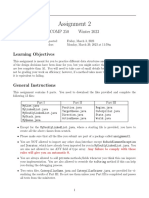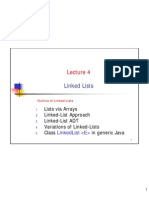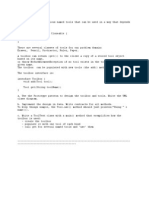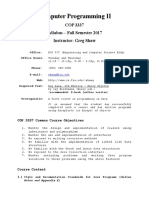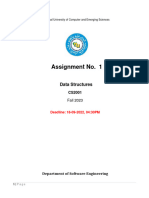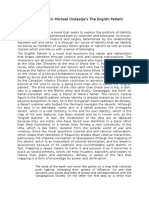EECS 2101: Assignment 1
Due: as set in eClass
May be done in groups of up to two students
TL;DR: implement 7 methods of the List interface, submit a java file for one class.
Cheating not allowed.
Motivation
The purpose of this assignment is to implement a variation of a linked list and to
investigate its time complexity for some of the list operations.
Introduction
Like the previous assignment, this assignment will involve (partially) implementing a
List1 interface. The List interface provides four methods for positional (indexed)
access to list elements, two methods to search for a specified object, and two methods to
insert and remove multiple elements at an arbitrary point in the list.
While some of these operations often execute in constant amount of time, the others may
execute in time proportional to the index value, depending on an implementation (the
LinkedList class, for example, is not very efficient when accessing elements in the
middle of the list using an index, and ArrayList does not allow for efficient insertion or
deletion, unless the element is at the end of the list).
Implementation
In this assignment, you will have to write a doubly-linked list-based partial
implementation of the List interface. Unlike the existing java.util.LinkedList, your
implementation is to optimize the operations involving the middle positions of the lists –
defined as list size / 2, enabling constant time operations involving not only the first and
the last positions of the list, but also the middle ones as well. You may review existing
LinkedList implementations as examples of how linked lists are usually implemented in
Java (you may not copy or re-use the code from there).
Ultimately, you should implement your class from scratch. Also, try to ensure the best
possible performance for all the implemented operations. E.g., to access the 47th position
of a 100-element list, one should not need to access more than three elements in addition
to the requested one.
1
https://docs.oracle.com/javase/8/docs/api/java/util/List.html
1
�Part 1
Implement the following public methods in your implementation of the List interface,
called MidLinkedList:
1. boolean add(E e)
2. void add(int index, E element)
3. E remove(int index)
4. E get (int index)
5. int size()
6. void clear()
7. String toString() (see Java API: AbstractCollection 2)
One public constructor should exist in your implementation: the one that takes no
parameters and creates an empty list when the class is instantiated.
The class should use generics. The behaviour of the methods in your implementation
should be equivalent to that of Java Standard Library’s classes (e.g., ArrayList; please
refer to the class API online). For the methods of the interface that you do not need to
implement, you may either leave them empty or throw an exception
public type someUnneededMethod() {
throw new UnsupportedOperationException();
}
Of course, you are free to implement any private or protected methods and classes as you
see fit. However, the methods mentioned above (or the ones present in the interface, or in
the class’ superclasses) are the only public methods your class may contain. Furthermore,
your code should not have any side effects, such as debug data printed to the console.
Part 2
Nothing needs to be submitted for this part; however, completing this part will provide
you an opportunity to investigate if your implementation is correct and to solidify your
understanding of linked lists.
Create some tester class and use it with your list implementation to investigate its running
time complexity as the number of items in the list increases and as you vary the indices of
the elements you are trying to operate on. Try measuring the running time when inserting
(deleting, getting…) 10, 100, 1000 … 1,000,000 elements at various positions. Confirm
that the running time follows the expected behaviour for add, remove, and for other
methods.
Furthermore, it is recommended that you practice writing unit test cases for your
implementation. In fact, it is often suggested that the test cases are written before the
implementation commences.
2
https://docs.oracle.com/javase/7/docs/api/java/util/AbstractCollection.html#toString()
2
�NOTES
1. Do not use package-s in your project (put your classes in the default package). Using
packages will cost you a 10 % deduction from the assignment mark.
2. Some aspects of your code will be marked automatically (e.g., how it handles
boundary cases and error conditions), using a custom tester class. It is also imperative
you test your classes. If any of the java files that you submit do not compile, the whole
submission will be given a grade of zero, regardless of how trivial the compiler error is.
The code you submit should compile using
javac *.java
command in either Windows, Linux, or MacOS.
3. Your code should include Javadoc comments.
4. Using any java.util implementations of Collection3 or Map4 interfaces is not
allowed (importing the java.util.List interface is of course fine).
Submission
Find all the java files in your project and submit them electronically via eClass (no
zipping is required). Only one file is expected, but you may write other classes, if you
deem them necessary.
If working in a group, make only one submission per group and include a group.txt
file containing the names and the student numbers of the group members. The deadline is
firm. Contact the instructor in advance if you cannot meet the deadline explaining your
circumstances.
Grading
The assignment will be graded using the Common Grading Scheme for Undergraduate
Faculties5. We look at whether the code passes the unit tests, satisfies the requirements of
this document, and whether it conforms to the code style rules.
Academic Honesty
Academic honesty will be strictly enforced in this course. Specifically, direct
collaboration (e.g., sharing code or answers) is not permitted, and plagiarism detection
software will be employed. You are, however, allowed to discuss the questions, ideas, or
approaches you take.
Cite all sources you use (online sources – including web sites, old solutions, books, etc.)
in your code comments; using textbook examples is allowed, but these must be cited as
well.
3
https://docs.oracle.com/javase/8/docs/api/java/util/Collection.html
4
https://docs.oracle.com/javase/8/docs/api/java/util/Map.html
5
https://secretariat-policies.info.yorku.ca/policies/common-grading-scheme-for-undergraduate-faculties/
3
�E.g.,
1) /**
* Constructs an empty list with the specified initial capacity.
*
* @param initialCapacity the initial capacity of the list
* @exception IllegalArgumentException if the specified initial
capacity
* is negative
* uses code from www.xxx.yyy.edu/123.html for initialization
*
*/
2) //formula based on Jane Smart’s thesis, page XX, available at
https://...
a = b + c;
Overall, although using outside sources is sometimes allowed, unless specified otherwise
– with proper citing, if the amount of non-original work is excessive, your grade may be
reduced. You might find the following article useful to have an idea what kind of
collaboration is appropriate: https://en.wikipedia.org/wiki/Clean_room_design
You may not post the contents of this assignment, nor solicit solutions on any
external resources.


